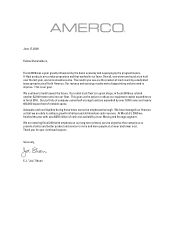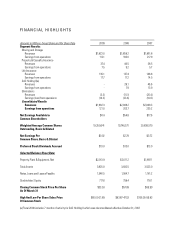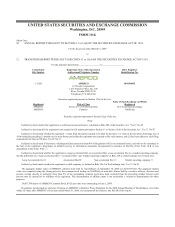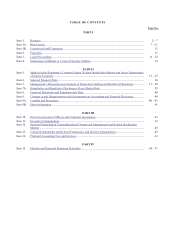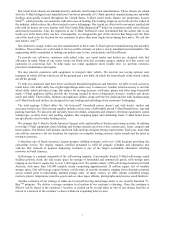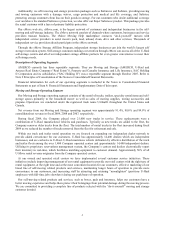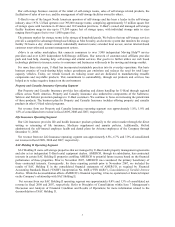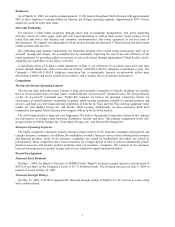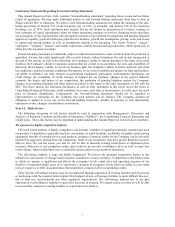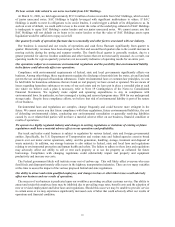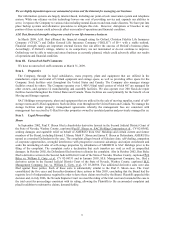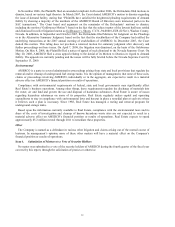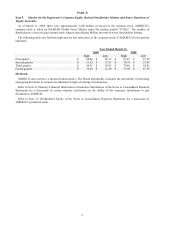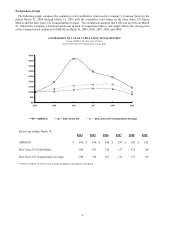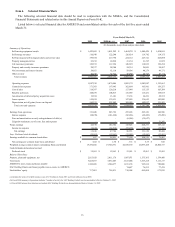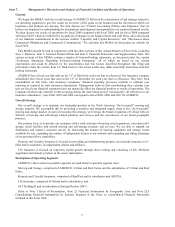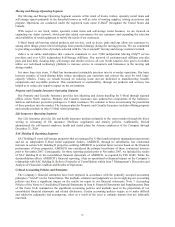U-Haul 2009 Annual Report Download - page 12
Download and view the complete annual report
Please find page 12 of the 2009 U-Haul annual report below. You can navigate through the pages in the report by either clicking on the pages listed below, or by using the keyword search tool below to find specific information within the annual report. 8
We are highly leveraged.
As of March 31, 2009, we had total debt outstanding of $1,546.5 million and total undiscounted lease
commitments of $625.2 million. Although we believe that additional leverage can be supported by the Company’s
operations, our existing debt could impact us in the following ways, among other considerations:
• require us to allocate a considerable portion of cash flows from operations to debt service payments;
• limit our ability to obtain additional financing; and
• place us at a disadvantage compared to our competitors who may have less debt.
Our ability to make payments on our debt depends upon our ability to maintain and improve our operating
performance and generate cash flow. To some extent, this is subject to prevailing economic and competitive
conditions and to certain financial, business and other factors, some of which are beyond our control. If we are
unable to generate sufficient cash flow from operations to service our debt and meet our other cash needs, we may
be forced to reduce or delay capital expenditures, sell assets, seek additional capital or restructure or refinance our
indebtedness. If we must sell our assets, it may negatively affect our ability to generate revenue. In addition, we may
incur additional debt that would exacerbate the risks associated with our indebtedness.
Current economic conditions, including those related to the credit markets, may adversely affect our industry,
business and results of operations.
The United States economy is currently undergoing a period of slowdown and unprecedented volatility, which has
resulted in a recession. The future economic environment may continue to exhibit weakness for an extended period.
This slowdown has and could further lead to reduced consumer and commercial spending in the foreseeable future.
Our industries although not as traditionally cyclical as some, could experience significant downturns in connection
with, or in anticipation of, declines in general economic conditions. Declines in consumer spending may drive us
and our competitors to reduce pricing further, which would have a negative impact on gross profit. A continued
softening in the economy may adversely and materially affect our industry, business and results of operations and
we can not accurately predict how severe and prolonged this downturn might be. Moreover, reduced revenues as a
result of the softening of the economy may also reduce our working capital and interfere with our long term business
strategy.
The United States credit markets are continuing to experience a contraction. As a result of the tightening credit
markets, we may not be able to obtain additional financing on favorable terms, or at all. If one or more of the
financial institutions that support our existing credit facilities fails, we may not be able to find a replacement, which
would negatively impact our ability to borrow under credit facilities. In addition, if the current pressures on credit
continue or worsen, we may not be able to refinance, if necessary, our outstanding debt when due, which could have
a material adverse effect on our business. While we believe we have adequate sources of liquidity to meet our
anticipated requirements for working capital, debt servicing and capital expenditures through fiscal year 2010, if our
operating results worsen significantly and our cash flow or capital resources prove inadequate, or if interest rates
increase significantly, we could face liquidity problems that could materially and adversely affect our results of
operations and financial condition.
Our fleet rotation program can be adversely affected by financial market conditions.
To meet the needs of our customers, U-Haul maintains a large fleet of rental equipment. Our rental truck fleet
rotation program is funded internally through operations and externally from debt and lease financing. Our ability to
fund our routine fleet rotation program could be adversely affected if financial market conditions limit the general
availability of external financing. This could lead to the Company operating trucks longer than initially planned and
reducing the size of the fleet, either of which could materially and negatively affect our results of operations.
Another important aspect of our fleet rotation program is the sale of used rental equipment. The sale of used
equipment provides the organization with funds that can be used to purchase new equipment. Conditions may arise
that could lead to the decrease in resale values for our used equipment, this could have a material adverse effect on
our financial results, which would result in increases in depreciation expense and losses on the sale of equipment
and decreases in cash flows from the sales of equipment.


